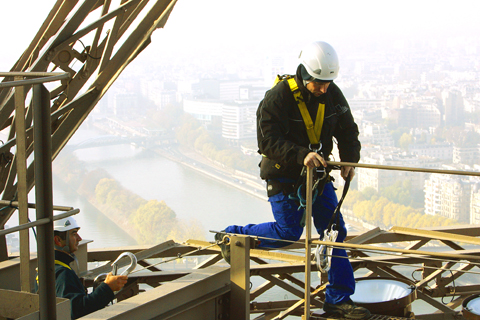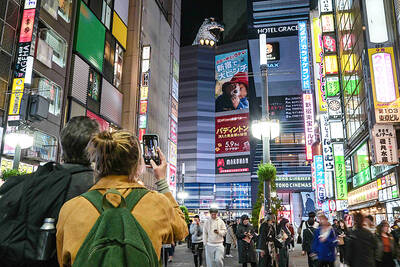A model of refined simplicity on the outside, the iron lady that symbolizes Paris is a complicated piece of work inside her elegant A-line figure.
Custom-fitted pumps, heaters and long-life bulbs keep the 119-year-old Eiffel Tower working and sparkling, while industrial-sized cogs, gears and cables spin, bump, grind and purr deep inside the structure’s innards, in places no tourists see.
Caring for the monument’s hidden core is a daunting, sometimes dangerous task that goes on out of sight but keeps the tower looking its picture-postcard best. More than 500 people — from welders and plumbers to security guards and cooks — work within the structure.

PHOTO: AP
“It’s a village here, full of life and very specific life forms,” said Yves Camaret, technical director of the company that runs the tower, as he led reporters on a tour of its many no-go areas.
Cavernous basements tucked beneath the tower’s legs house massive, hydraulic motors that power the two visitors’ elevators.
Descending the spiral staircase into the fosse, or pit, is like stealing onto the set of Modern Times, Charlie Chaplin’s 1936 vision of industrial society. Oversized cogs spin slowly, gears painted vibrant primary colors chug, and metal cables with the circumference of a dessert plate uncoil and recoil like anacondas.
A 4,000-liter tank full of water, which was once pumped in from the nearby Seine, provides the counterbalance needed to hoist the roughly 18,000 visitors per day up to the 115m high second-level landing.
The motor’s myriad clanking parts need frequent oiling, and workers inspect them daily. Even a short, half-hour breakdown of one elevator can double the lines of visitors.
The City of Paris owns the tower, which made more than 1.4 million euros (US$1.8 million) in 2007. The money goes back to its shareholders, which include the City of Paris.
It draws around 7 million visitors annually, making it one of the world’s top tourist attractions and a potential target for terrorists, though so far only in fantasy, as in the 1980 movie Superman II.
“It’s a symbol, therefore it’s a target,” Camaret said.
The tower’s security detail is “extensive,” he said, declining to give details.
Guards also have to watch for suicides — one jumper a year on average, Camaret said. The last was a man who leaped to his death early last year, he said.
Designed by the tower’s architect and namesake, Gustave Eiffel, the visitors’ elevators were installed in 1899 — 10 years after the tower opened. Together with the more modern elevators that go up to the 276m high summit observation deck, they travel more than 99,775km up and down each year.
The wear and tear takes its toll. A restoration is under way to replace all the pieces of one of the aging hydraulic motors.
Exact copies of each and every original gear, wheel and screw are being cast in foundries in France and Germany, for 20 million euros, said Eric Trahand from the elevator maintenance team.
Aside from visitors, everything else goes up and down on a modern electric elevator.
From knickknacks on sale in the gift shop to baguettes and bubbly served in the restaurants — celebrated French chef Alain Ducasse’s chic Jules Verne and the casual Altitude 95 — everything goes through X-ray machines. They are then packed into sealed containers, like padlocked refrigerators on wheels, for the trip into the sky.
Subterranean pumps send water shooting up to tower-top sinks and toilets.
Dozens of kilometers of plumbing are integrated into the structure of the monument, exposing the pipes to the elements.
Mini-heater coils prevent them freezing when the thermometer drops, so the sinks run and toilets flush even in the harshest winters.
It takes a team of 30 painters working full-time over 18 months to spruce up the tower with a fresh coat of its signature bronze paint.
Even changing a light bulb becomes a major production.
To replace one of the 360 spotlights, specially trained technicians don mountain-climbing gear to scale the iron crossbeams. Working in pairs for safety, they are fastened by nylon climbers’ cords to the structure at all times, with their tools strapped to their belts to prevent accidents.
“If you drop something, anything, even a thing as small as a screwdriver can kill,” said electrician Henri Pellier, 44, who has worked at the tower for 14 years.
Neither Pellier, nor his partner, 32-year-old Eric Auzolles, had any climbing experience before they were hired. They were trained by experienced mountain climbers.
“For me, climbing is a pleasure,” said Auzolles as he strapped himself into a yellow harness and donned a hardhat. “It’s like being on top of a mountain ... We’re missing out on the snow and the sun, that’s all.”

POLITICAL PRISONERS VS DEPORTEES: Venezuela’s prosecutor’s office slammed the call by El Salvador’s leader, accusing him of crimes against humanity Salvadoran President Nayib Bukele on Sunday proposed carrying out a prisoner swap with Venezuela, suggesting he would exchange Venezuelan deportees from the US his government has kept imprisoned for what he called “political prisoners” in Venezuela. In a post on X, directed at Venezuelan President Nicolas Maduro, Bukele listed off a number of family members of high-level opposition figures in Venezuela, journalists and activists detained during the South American government’s electoral crackdown last year. “The only reason they are imprisoned is for having opposed you and your electoral fraud,” he wrote to Maduro. “However, I want to propose a humanitarian agreement that

ECONOMIC WORRIES: The ruling PAP faces voters amid concerns that the city-state faces the possibility of a recession and job losses amid Washington’s tariffs Singapore yesterday finalized contestants for its general election on Saturday next week, with the ruling People’s Action Party (PAP) fielding 32 new candidates in the biggest refresh of the party that has ruled the city-state since independence in 1965. The move follows a pledge by Singaporean Prime Minister Lawrence Wong (黃循財), who took office last year and assumed the PAP leadership, to “bring in new blood, new ideas and new energy” to steer the country of 6 million people. His latest shake-up beats that of predecessors Lee Hsien Loong (李顯龍) and Goh Chok Tong (吳作棟), who replaced 24 and 11 politicians respectively

Young women standing idly around a park in Tokyo’s west suggest that a giant statue of Godzilla is not the only attraction for a record number of foreign tourists. Their faces lit by the cold glow of their phones, the women lining Okubo Park are evidence that sex tourism has developed as a dark flipside to the bustling Kabukicho nightlife district. Increasing numbers of foreign men are flocking to the area after seeing videos on social media. One of the women said that the area near Kabukicho, where Godzilla rumbles and belches smoke atop a cinema, has become a “real

‘WATER WARFARE’: A Pakistani official called India’s suspension of a 65-year-old treaty on the sharing of waters from the Indus River ‘a cowardly, illegal move’ Pakistan yesterday canceled visas for Indian nationals, closed its airspace for all Indian-owned or operated airlines, and suspended all trade with India, including to and from any third country. The retaliatory measures follow India’s decision to suspend visas for Pakistani nationals in the aftermath of a deadly attack by shooters in Kashmir that killed 26 people, mostly tourists. The rare attack on civilians shocked and outraged India and prompted calls for action against their country’s archenemy, Pakistan. New Delhi did not publicly produce evidence connecting the attack to its neighbor, but said it had “cross-border” links to Pakistan. Pakistan denied any connection to